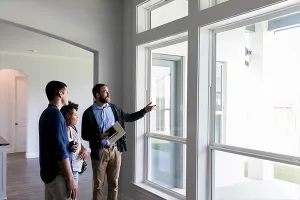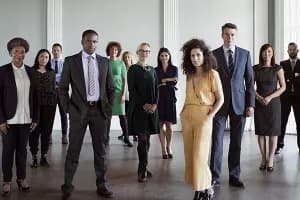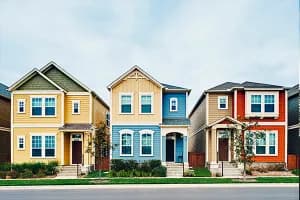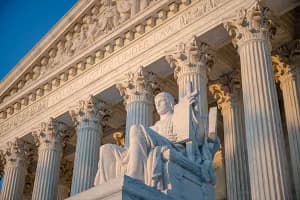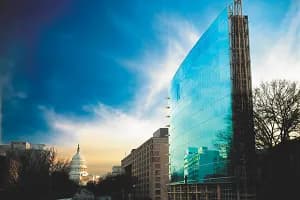By Steve Wright
Cities benefit from using the arts as an economic development tool.
From almost the beginning of time, the arts have been supported by everyone from monarchs to popes to commoners because of its humane, beautiful, spiritual and life-affirming qualities.
In these challenging economic times, an equal argument can be made for valuing the arts like precious infrastructure, as important to cities as walkability, transit and parkland, and as essential as streets, water and sewer lines.
Countless cities — from obscure to famous, from modest to sophisticated — have used the arts to revitalize old neighborhoods, create nightlife in fading downtowns and spur economic development in tough times.
In Ventura, Calif., the arts are at the center of a landmark development that combines market-rate condominiums, affordable space for artists and even transitional housing for formerly homeless people — all in a LEED-certified green building that is just a few blocks from both down-town shopping and the Pacific Coast beach.
The $61 million mixed-use, mixed-income utopia is called WAV — Working Artists Ventura. It has 54 live-work units for artists with monthly rent starting at $400. The top floor features market-rate lofts selling for more than half a million dollars per unit — which helps subsidize the cost of the affordable units. There are also 15 units of transitional housing available for low income renters who do not have to be artists.
“The WAV is an economic engine and a cultural force,” said Ventura City Manager Rick Cole. “It brings scores of artists into permanent residence in our downtown, provides an accessible new performance space, provides a home to individuals and families climbing out of homelessness, and represents an exciting mix of uses and incomes. On top of all that, the LEED certification validates the vision that brought this unique community-within-a-community into being.”
“At a time when every other mixed use and housing development stalled, the WAV opened to rave reviews,” Cole added. “It has kept the momentum going by bringing exciting new life to our historic downtown.”
The sustainable structure — developed by the Minneapolis-based nonprofit PLACE (Projects Linking Art, Community & Environment) — has 6,100 square feet of ground floor space for arts-friendly businesses such as coffee houses, galleries and sidewalk cafes.
WAV provides affordable living and working space for more than 100 artists of every kind including painters, sculptors, dancers, poets, musicians and filmmakers. The WAV Theater Gallery offers performances, art openings and public gatherings.
REALTOR® Doug Moe, of Keller Williams Realty, has been selling homes and taken an active role in the Ventura community since 1976. Charged with selling the market rate, solar-powered, double-floor, loft condominiums at WAV, he is a huge supporter of the diverse development.
“When I really found out exactly what was going on at WAV, I thought ‘man, somebody did something great to get Ventura this fabulous project to completion in this economy,’” Moe said. “There were 800 applicants for the 54 units of artist housing — that tells you how popular this is.”
“This is very important to the residents of Ventura — we see what’s going on with the environment; we want a higher quality of living,” he continued. “WAV addresses so many issues important to us — affordable housing, having different segments of society living here. WAV also demonstrates that you can build affordable housing that is LEED certified and that you can build a mixed-income gem like this without the city pouring money into it.”
Chris Velasco, who founded PLACE in 2005 and serves as its president and executive director, has been actively engaged in the creation of innovative communities and sustainable facilities for 16 years. He has worked in more than 200 communities, creating more than $350 million worth of new, arts-centered facilities.
“Art is fundamentally a process and not a product,” Velasco said. “There is a strong temptation to go to a museum and say ‘this is where art lives,’ but it really takes place over a cup of coffee talking with an artist over their canvas, or in a loft with the dancers creating their dance. That is why I have spent nearly two decades of my life building very specialized spaces for the arts.”
Charlottesville, Va., may have fewer than 50,000 residents, but its vibrant arts community creates a quality of life that ranked the home of the University of Virginia as the best place to live in the United States in the book “Cities Ranked and Rated.”
In 1976, the city of Charlottesville turned a decommissioned 1916 federalist style brick school building into the McGuffey Art Center — a vibrant place where dozens of artists rent studio space far below market rate.
In return for low rent, artists agree to open their studio spaces to the public for a required minimum of at least 17.5 hours per week.
“It humanizes the process — people walk right in to your studio and begin to realize there are flesh and blood people making these things, and these people have a role in the community,” said sculptor Jim Respess, who has been at McGuffey for two decades and chairs its gallery committee. “It’s a nice fit: we have a really nice exhibition space, but the lion’s share of what goes on at McGuffey is people can walk in ‘and see the dirt on the floor’ — the process (of making art) unfolding.”
Respess said progressive cities view the arts and artists as part of the fabric of the community and as a vital cog in the engine that drives economic vitality in core neighborhoods.
“One of the issues we wrestle with is ‘how do you maintain the artistic integrity of the building with downtown rents around it going through the roof?’ It’s tough for the city, because the city is not getting property tax from us,” Respess explained. “The city has been very, very supportive of what’s going on at McGuffey. We benefit from a city council and city environment that has embraced the idea of the artistic process at the core of the city. The people here understand that our presence is as important as the objects we make.”
Respess praised city leaders who support the art center and its recent designation on the National Register of Historic Places and the Virginia Landmarks Register.
“I feel very fortunate to be here, and I take McGuffey very seriously,” he said. “It is a beautiful old federal style building. If you took it away, you would destroy something that is homegrown and part of daily life in the downtown of one of the most special cities anywhere.”
Photographer Will Kerner, an associate artist who exhibits at McGuffey, but does not have studio space there, agrees that the arts are key to making downtown Charlottesville a viable district where land values have appreciated.
Kerner has been instrumental in starting several stalwart live performance and other artistic nonprofits in the center of Charlottesville.
“When we started 20 years ago, downtown was a quiet place after dark. Very few businesses were open past 5 (p.m.) and maybe only three or four restaurants were open,” he recalled. “Along with a downtown pedestrian mall, the arts have made this a hub of activity for the community. Now there are 15 or more restaurants open after dark downtown. Several developers have converted old buildings into loft living spaces, and others have built new buildings for very upscale downtown living.”
Two decades ago, Kerner founded Live Arts, a community theater organization that started in an old building offered at below market rent by a savvy landlord who knew that cultivating an arts community would eventually give him a large return on his investment.
Today, Live Arts is located in a modern, funky, steel building known as the Community Center for the Contemporary Arts, which houses gallery and performance space worthy of a city 10 times the size of Charlottesville. Live Arts produces everything from traditional to experimental theater that fills the space about 100 nights per year.
“When you support the arts with money, space and volunteers, pretty soon you become known as a regional spot where a lot of cultural activity is happening,” Kerner said. “And now you have lots of downtown living — with significant conversions, renovations and brand new construction over the past 20 years. The once sleepy downtown now has dwellings selling for a half million dollars.”
Minneapolis-based Artspace has developed affordable artist live-work spaces in dozens of cities across America. The national nonprofit developer arose out of an advocacy group trying to protect cheap spaces for artists in the Minneapolis-St. Paul area.
“Finding and retaining affordable live-work space is an age-old problem for artists, painters, sculptors, dancers and others who require an abundance of well-lit space in which to work. Many artists gravitate to old warehouses and other industrial buildings, but their very presence in an industrial neighborhood often acts as a catalyst, setting in motion a process of gentrification that drives rents up and forces the artists out,” Artspace explains on its website.
Striking the delicate balance of uplifting industrial, warehouse and forgotten areas through the arts — while not gentrifying working class artists out of the very neighborhoods they pioneered — is an ongoing challenge.
Fort Lauderdale, Fla., has transformed from a sleepy beach town into the hub of an immensely-populated county — where lots of high-priced, high-rise housing has crowded into the city’s modern downtown along the historic New River.
In a public/nonprofit partnership with the Broward County Cultural Division and the city of Fort Lauderdale, Artspace created 37 units of affordable live-work studios for individuals and their families in Fort Lauderdale’s historic Sailboat Bend neighborhood.
The Sailboat Bend Lofts project was the result of a decade of work in the community. In addition to the newly constructed lofts, the project also renovated the Historic West Side School, built in 1923, as the new home for the Broward County Historical Commission. This new facility is located within walking distance of downtown Fort Lauderdale and its many cultural facilities.
“There’s a lot of very strong inherent value in artists and the arts and the creative sector,” said Bill Mague, vice president and portfolio director for Artspace. “But one could argue by the colloquialism ‘starving artist’ that we don’t value that enough in our society.”
Mague said Artspace has been successful in underscoring the value of artists in dozens of cities in America.
“We demonstrate that value is delivered when there’s a congregation of artists. We show cities that they need to protect the people who are participating in art,” he continued. “There is a great benefit when the community invests in a strategic asset of long-term, affordable space for artists.”
Urban-focused REALTOR® Carson Brooks, owner of EXIT Realty Metro in Minneapolis, links the arts with sustainable economic recovery and the future of our cities.
“I made a huge move out of a large suburban real estate office where I was managing broker into a small start-up in the city. We opened our office next door to a nationally known contemporary art museum and public sculpture garden,” Brooks said. “A big part of my initiative in doing this was about the major shift our economy is forcing on all of us. Urban sprawl was a part of our nation expanding beyond its means. The infrastructure, in most cases, remains in our cities, and needs energy and rejuvenation.”
Brooks said the rejuvenation at the core of many of our nation’s large cities begins with arts and culture.
“It is an amazing concept when a tired, quasi-industrial area of a city can germinate an artist-friendly neighborhood,” he explained. “It can begin with affordable studio space in old warehouse buildings and grow with coffee shops and retail in the same locations where pre-WW II grocers and corner bars once thrived.”
“My city, Minneapolis, has at least two such areas: the more urban warehouse district in the North Loop, and the quieter Northeast area of Minneapolis. The arts movement in each of these areas has brought about a growing need for housing and services in what were tired and rundown urban neighborhoods,” Brooks continued. “The accessibility of culture, localized retail and great restaurants have brought new buyers looking for a friendly, walkable neighborhood without a commute to the downtown business districts. This has stabilized and improved property values in many of these urban neighborhoods.”
Brooks praised cities that are rebuilding transit with light rail and other options where city residents can get to airports and suburban resources without a car.
“Our national economic slump will not last forever, but the way we live in and around our cities may be changed for the long haul,” he observed. “Those little arts quarters growing in our cities may be a great piece of the solution to re-building our nation.”
Ogden, Utah, a railroad town of the old west, is thriving again after pinning much of its economic rebirth on the arts. Matthew R. Godfrey, mayor since 2000, has worked hard to strengthen Ogden’s historic downtown through the arts.
“Ogden City embraces art as a vital part of our economic development and our community,” said Carolyn Brierley, Community & Events Coordinator for the Ogden City Corporation. “We were the first city in Utah to implement a Percent for Art program whereby we set aside 1 percent of all capital improvement projects to create public art installations. The city council also allocates funding every year to give arts grants to local organizations (including non-arts organizations) for arts projects or for general support.”
“The mayor implemented a Mayor’s Awards in the Arts program whereby he recognizes a few individuals each year for their contributions to the arts,” she continued. “We hold an annual arts town meeting to bring art organizations together to network and learn about each others’ programs. We have a mayor-appointed arts advisory committee that oversees all of these projects. The committee is made up of individuals representing the eight major art disciplines — music, dance, theater, design, literary arts, visual arts, folk art and media arts.”
The arts have played a big role in the resurgence of 25th Street — the heart of Ogden’s Historic District. The 1923 Italian Renaissance Union Station has been transformed from an important rail hub to the hub of downtown, with museums and events housed within its refurbished walls. Historic 25th, as 25th Street is known, offers galleries, dining, boutique shopping, a comedy club, amphitheater and national comedy acts at the historic, 1920s Peery’s Egyptian Theater.
“The historic district in Ogden is also known as the arts district. Numerous art galleries thrive there and all participate in a monthly gallery stroll that brings hundreds if not thousands of people to the downtown district,” Brierley said. “Each features a new artist each month. Public art installations outdoors have increased our tourism. The district has a renewed vitality, and businesses are striving to move into the area to take advantage of that vitality.”
Brierley said performance and visual arts events bring citizens together for a common cause and give downtown businesses the opportunity to market themselves to an audience that may not otherwise visit the area.
“Our Historic 25th Street and the upper east side of the city have increased greatly in value,” she said, noting that numerous historic dwellings have been remodeled and upgraded thanks to the arts renaissance. “25th Street used to be known as a very dangerous place where prostitutes, alcohol and drugs were the mainstay. Now retail shops, restaurants, businesses, a comedy club and an amphitheater fill the street.”
In the 1990s, a chunk of Downtown Los Angeles was dominated by drug dealers and gangs. Artists, art galleries and like-minded urban pioneers helped fill vacant buildings and vacant lots while taming the mean streets of LA’s Main Street.
Tom Waits wrote a song about The Nickel, an oddball ode to the hustlers, lost souls and worse who inhabited 5th Street. No corner was worse than 5th and Main— before the arts changed everything.
“In the late ‘90s, more drugs were sold on that corner— 5th and Main — than anywhere in the world,” said Brady Westwater, a character as big and over the top as the star-struck and quake-prone City of Angels, who calls himself the unhired, unpaid “curator” of Downtown Los Angeles. “On the longer blocks, 80 to 90 drug dealers were out leaning against a building or standing on the sidewalk waiting for cars to drive up to buy drugs 24 hours a day. They had tents there that they rented to people to crawl in and do their drugs.”
Westwater, a 60-something urban cowboy, and a few other arts-minded entrepreneurs all landed within a few blocks on 5th and Main when the area was at its most drug-deluged and decrepit.
Westwater and others went about convincing landlords that they would get a large return on their long-term investment if they started cleaning up the area by offering studio, gallery and living space to artists for very low rent.
“The renowned Bert Green Fine Art gallery moved from West Hollywood to Downtown, and soon there were five popular art galleries in the area of 5th and Main,” Westwater said. “We kept clearing the drug dealers out and then we tackled Winston, a small street near 5th and Main so dangerous that people wouldn’t cross a half block of it in the daylight.”
The area still has plenty of rescue missions and social service agencies, but they share the former mean streets with chic restaurants, hip bars and galleries that make up one of the most popular monthly art walks in the nation.
“Believing in the power of the arts to transform, I helped found Downtown LA’s Gallery Row, Art Walk, Neighborhood Council and Downtown Fashion Week,” Westwater said, noting that a half dozen new loft residential spaces have also opened in the once abandoned and lawless historic core. “I also did most of the leasing of the art galleries and then the fashion stores in the area, pro bono. The arts community took the worst part of the downtown heroin district and turned it into the creative heart of Downtown.”
Wright frequently writes about Smart Growth and sustainable communities. He recently participated in the prestigious Forum on Land and the Built Environment: The Reinvented City sponsored by the Nieman Foundation for Journalism at Harvard University Lincoln Institute of Land Policy, Harvard University Graduate School of Design. Contact him at stevewright64@yahoo.com.
